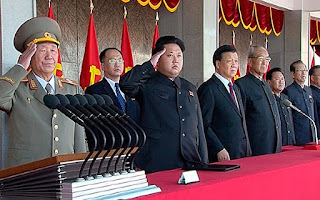Why the Chinese need the Spratlys and Paracels artificial island in the South China Sea
Why
the Chinese need the Spratlys and Paracels
artificial island in the South China Sea
By
E. Stanley Ukeni
China’s ambitious land reclamation project on the
Spratlys and the Paracels Island chain has continued to stoke tension between
the Chinese government and its neighbors—and eroding the confidence of regional
governments within the ASEAN Regional Forum. In fact speculations abound
regarding what China intends to do with the massive artificial island it is
constructing in the South China Sea.
Before I proceed, I deem it appropriate to point out
that the Chinese National Development and Reform Commission has come out to state
that the artificial island in the South China Sea is intended primarily for
civilian and emergency use, and I for one have no reason to doubt this official
assertion by China’s top national planning agency. I am only venturing with
this strategic analysis to explore a potential extreme military scenario. Well,
now that I’ve dispensed with the tact disclaimer, let me proceed with my hypothesis.
It is obvious
by now that China is not constructing a paradise island resort. The country’s
officially declared main purpose for the artificial island—which is to support
such civilian activities as maritime and rescue and scientific research, does
not quite explain the need for the Chinese government to expend enormous
financial and material resources to execute such a large scale construction
project when a modestly smaller outpost can serve the declared purpose.
Although China has declared that its secondary use
of the expansive artificial island includes advancing its newly upgraded
military strategy of open seas protection, and offshore water defense. It is
not likely that this declaration will reduce regional tension much. In fact the
prospect of a militarization of the South China Seas is exactly the main reason
that China’s neighbors are antsy.
However, China seems unfazed by the increasing
agitation of its neighbors, as its land reclamation activities is still
continuing at, at least, two of the seven land reclamation sites in the Spratlys
Island chain—specifically at Mischief Reef and Subi Reef, according to a
Washington-based think-tank, the Asia Maritime Transparency Initiative. The Chinese
on proceeding with the island construction project irrespective of what any
other country thinks.
The United States has in recent months employed
various diplomatic means in other to persuade China to abandon the South China
Seas land reclamation project to no avail. The Chinese are continuing with the
artificial island project despite the US government rejection of China’s claim
to the Spratly and Paracels’ island chain. According to a statement by Senator
John McCain, it would seem that US government have opted for a tact approach to
how it is confronting China over its increasingly secretive island construction
in the South China Sea. I suspect that the United States’ policy makers and
military planners has done a cost/benefit analysis of the situation, and
perhaps, concluded that the risk of an all-out military confrontation with
China outweighs any potential gains from such antagonistic strategy.
In preparing to write this blog article, I started
to ponder on why the Chinese government would insist on continuing with such a colossal
project in the South China Sea amidst the contentious backlash from its ASEAN
neighbors, some of whom are claiming parts of the island chains as their own.
Then, in a moment of epiphany, the brilliance of what the Chinese are aiming to
achieve with the artificial island dawned on me. Of course the theory that I’m
about to advance is mere conjecture on my part, at this point. There is no
definitive evidence to clearly substantiate the assertions here, at least for
now.
Well, it is no secret that the Chinese Navy far lags
behind the United States’ Navy in the key area of forward-force projection
capabilities. It is equally an established fact that the People’s Liberation
Army would like to leapfrog into parity with the US Navy as quickly as
possible. Supporting this assertion is the policy document issued by the State
Council—China’s cabinet body, which indicates that the country’s air force
would shift its focus from territorial air defense to both offensive and
defensive air defense. The same policy paper informs that the Chinese People’s
Liberation Army (PLA) intends to build a network of airspace defenses with
enhanced military capability, which would provide an arch of air defense around
its coastal regions, in the near future.
In other to achieve these lofty goals and objectives
a country would need to have at its control the sort of naval assets that only
the United States’ Navy possesses—chief among these assets would be the command
of a sizable fleet of super aircraft carriers. The Chinese most certainly do
not have these, at least not yet. This has to lead one to wonder how the naval
force of Chinese Liberation Army hopes to match the US naval superiority in
firepower—with its impressive aircraft carrier fleets of at least ten USS
Nimitz-class aircraft carriers and another nine USS America-class flat-decked,
aircraft-carrying, amphibious assault ships. The Chinese People’s Liberation
Army’s Navy currently has one Liaoning-class
aircraft carrier, though it intends to float four super-carriers by 2020. A lone carrier cannot conceivably serve the
defense objects that the policy paper has outlined.
It’s not that the Chinese ships builders and
engineers cannot, or has not yet mastered the ability to, construct and float a
Nimitz-class aircraft carrier. It’s just that the time it would take the
Chinese Navy to acquire enough of these super carriers to even near the current
US naval fleet numbers makes the possibility of the Chinese Navy attaining
parity with the US Navy unlikely any time soon. However, a forward located and
sizable island—equipped to support all the functionalities of an aircraft
carrier, quickly becomes an expedient and viable alternative to solving a
strategic military deficiency, in the near-term.
I think that the Chinese defense establishment is
aiming to leapfrog into parity with the US naval force projection capabilities
with the expansive artificial island it is constructing in the South China Sea,
and future land reclamation projects—in perhaps the East China Sea and the
Indian Ocean. I think that a few more of these artificial islands in strategic
areas, and China would only need maybe three or four aircraft carriers to
achieve strategic parity with the US Navy. This is definitely achievable within
the next decade.
My rudimentary analysis suggests that, if the
artificial island that the Chinese is constructing in the South China Sea is
fully militarized, it would easily serve the functionality of at least two to
three aircraft carriers. The expansive two thousand acres plus land area that
the Chinese dredging and engineering companies have already reclaimed from the
sea is more than sufficient forward operating military outpost to deploy and
maintain both defensive and offensive advanced weaponry.
Think about it, the artificial island’s strategic
location close to the center of the South China Sea means that it would be an
ideal location for basing the ubiquitous Russian made S-400 Missile Defense
System that the Chinese government acquired earlier this year. This highly
sophisticated air defense system is capable of firing several types of
missiles, and can simultaneously engage thirty-six independent targets within
an impressive range of two hundred and forty-eight plus miles (400 km)—creating
a multi-layered extensive perimeter defense zone.
If this advanced Missile Defense System—augmented
with Chinese build HQ-9 and HongQi-10 advanced surface-to-air missile systems,
were to be successfully deployed in the Spratlys, and, or the Paracels Island
area, almost all conventional military threats that the Chinese People’s
Liberation Army (PLA) are currently contending with in the Asia-Pacific theater
of operation would conceivably be neutralized. Under this scenario, the US
defense department would have to field even more sophisticated weaponry to keep
its military outposts in Japan, South Korea and Guam both defensively and
offensively viable. I’m fairly certain that the Chinese defense department is
seriously contemplating, or may have already decided, to field these impressive
air defense systems at the artificially constructed island when completed.
Equally,
recent satellite imagery of the man-made Spratlys and the Paracels Island land
reclamation project shows that two, approximately one and half miles (3 KM)
long, tarmac has been laid for an expansive airstrip complex. At least one of
these lengthy runway strips is within an aviation safety range for the PLA’s
Air force bombers like the H-6, the strategic transport aircrafts such as the
Ilyushin II-76 and a range of military surveillance planes to effectively
takeoff and land. This is understandably a worrisome development for China’s
regional rivals.
An even more disturbing aspect of the airstrip
complex construction is the prospect of the complex playing host to dozens of
J-11 and J-16 advance fighter jets at any given time. At least one of the two
airstrips on the man-made island is capable of supporting the fifth generation
J-31 Stealth Fighter jets once they become operational.
If China’s PLA were to augment its deployment of
advanced air force planes with an even more robust deployment of strategic
short to medium range ballistic missiles at the artificial island in the
Spratlys, it would indicate a potentially new phase in its militarization
project. If this potentially provocative scenario were to occur, it might be an
indicator that China might be moving toward the establishment of an Air Defense
Identification Zone (ADIZ) in the South China Sea.
Although high-level US government functionaries have
clearly indicated that the tension between the US military and the Chinese PLA
over China’s sovereign claims to the Spratlys and Paracels Island chain will
not lead to military conflict between the two superpowers, I am of the opinion
that the United States will apply such diplomatic pressure on China over the
issue in a bid to discourage China from venturing to construct additional
artificial outposts in either the East China Sea or the Indian Ocean, and
perhaps elsewhere.
Authored
by E. Stanley Ukeni, © 2015. All Rights Reserved.












Comments
Post a Comment